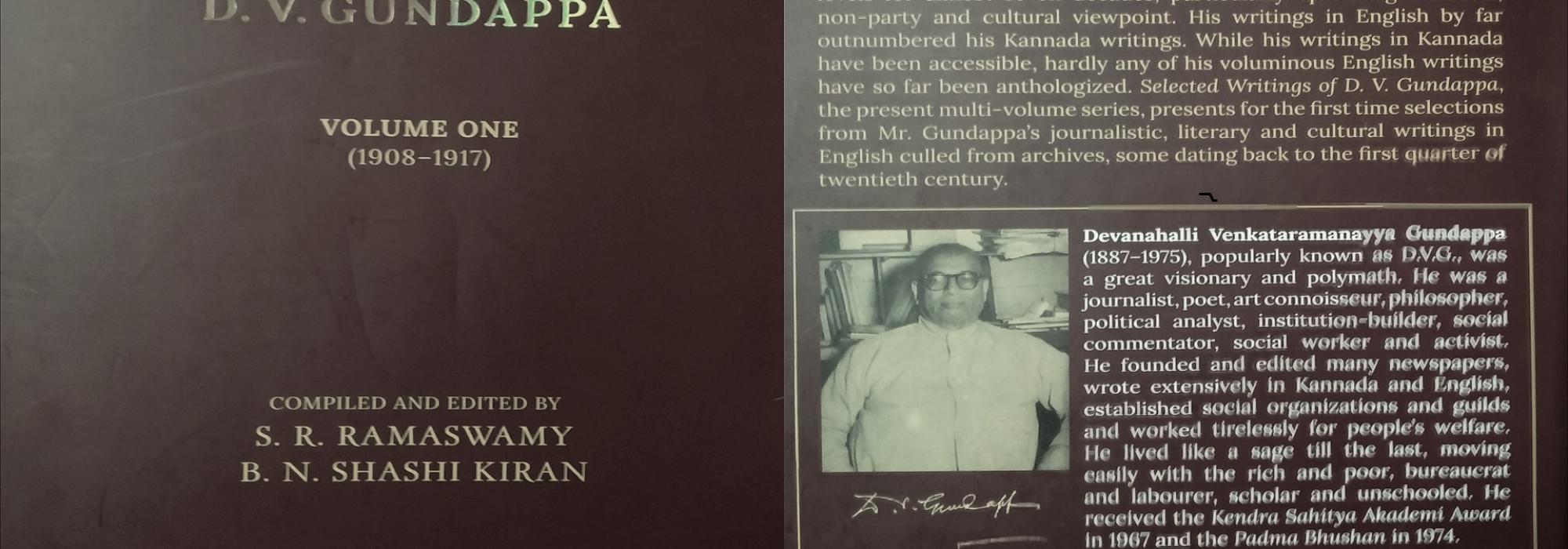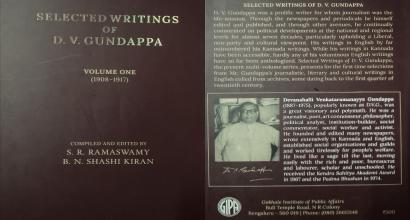Like all conscientious citizens endowed with intellectual integrity, DVG was a caustic critic of the Indira Gandhi Government. He repeatedly pointed out the unsoundness of her schemes and slogans, the most glaring example being Garibi Hatao:
Mrs. Indira Gandhi has over-simplified the problem of poverty as she has over-simplified even the problem of wealth. She and her father have tried twenty-five years to create wealth with the only result of increased debt burdens and ever–increasing unrest. To create wealth is first of all to ensure honesty and reliability among the people concerned. On the other side, Garibi Hatao is not snatching land from those who have some and distributing it among others, one acre or two acres apiece. Garibi Hatao is, first of all, improving both character and outlook among the poor. A great many of the poor were not so poor once even as a great many of the rich were not so rich before they became Ministers or their favourites five or ten years ago. Poverty has causes and if you would give relief to the poor, you should attack those causes. It is moonshine to say that if you give them one or two acres of land each and a loan of one or two thousand rupees each, their character and outlook will be re-oriented to constructive ends. Improvidence and recklessness are deeply ingrained habits as are also those of wasting money when you have it and of not counting on the morrow. These deficiencies of the mind and the will are the root causes of Garibi, — causes greater than somebody else’s possession of resources. (p. 53)
When the Tamil Nadu Government derecognized the hereditary rights of temple archakas, DVG argued in favour of these keepers of tradition. Apart from adducing evidence from a civilizational point of view, he spoke in the language of law and pointed out that it is customary law that prevails in the matter:
The petition of temple priests (archakas) in the Tamil Nadu to the Supreme Court for the declaration of their priestly right as a hereditary office, has been dismissed. We have to respectfully point out that hereditariness or inheritability of priesthood is the heart of the rubric of Hinduism … There is no statute law prescribing that a priest should be one hereditarily descended. But the law that prevails in this matter is customary law. There is such an office as a family purohit. The purohit, for all Hindu classes, has till now been a Brahmin by birth. The point for us is not whether it is right and proper that it should be so. If the fact is not correct or proper, it is for the Legislature to correct it hereafter. Taking things as they are, according to common or customary law, we have to recognize the hereditary rights of temple priests, as of certain other classes of servants of the public in the Hindu community. (p. 130)
Since the advent of the vicious Dravidian ideology, Tamil Nadu has been a hotbed of problems. Language chauvinists are increasingly creating fault-lines that threaten national unity. One of the prime forces behind this contemptible hatred is E V Ramaswamy Naicker. After witnessing scary mob uprisings in the State and noting that the DMK Government was actually fanning the fire, DVG wrote an editorial to call for Union intervention:
Conditions of life are becoming intolerable under the Karunanidihi Government in Tamil Nadu and it is time the Government of India stepped in to stop the mob upheaval in the Province. When a movement is founded upon the hatred of some body of men or against an institution the movement cannot last in glory for very long. General hatred must breed particular hatreds and they are bound to grow and ramify. That seems to be the history of the movement started by E.V.R.—Periyar, and it is to the credit of the late Annadurai that he kept it comparatively innocuous for some time. After him, other elements have come into prominence in the party and its wheels are running helter-skelter. From reports so far available, Tamil Nadu seems to be heading for a kind of civil strife and it is clearly the duty of the Union Government to take steps that will end the civil strife. People like the late Sir P. S. Sivaswami Iyer feared such a development and insisted on the Centre retaining full authority to stop injustice in any form, and stop the breaking up of India. The D.M.K. has had its chance to play long enough and it has not played the game according to rules. It is to be hoped that Mrs. Indira Gandhi realizes the ominous nature of this situation and steps in to set things right without mincing. It is not the entire Province of Tamil Nadu that is behind D.M.K. As a matter of fact, the bulk of the population is not of the D.M.K. persuasion and will welcome remedial action by the Centre. If things are not definitely and by drastic action set right in Tamil Nadu, the danger is that the bad example will spread into other parts of South India. (p. 166)
* * *
Volume Eleven (1974–1975)
DVG wrote a major part of the essays included in this volume when he was well into the evening of life. During those days there arose an occasion when he had to summon up his entire energy and address himself to a task. He had to put together a philosophical discourse on Advaita: Faith and Practice as per the desire of Jagadguru Sri Chandrashekharendra Saraswati, Swamiji of Kanchi Kamakoti Peetha. The Mahaswami’s wish was for DVG a command. He dictated the entire lecture, most of it lying in bed. It is fitting that the last major writing of DVG was on a topic most close to his heart.
He began the lecture by referring to the unparalleled opening statement of Shankaracharya’s Adhyasa-bhashya and explained:
Advaita is the denial of the duality (dvaita) of Being with which we are familiar on every side and practically every moment. This familiarity with dualism is seen when we say ‘I and you’ or ‘you and he’ or ‘I and he’; or it may even be ‘the world and God.’ The distinction we make when we speak thus is no less figurative and no more realistic than what we imply when we say ‘my front’ and ‘my behind.’ Is it not but an imaginary line that divides the front from the rear of one and the same body? Parama and jiva are similarly the aspects of one and the same atman.
Expounding on the salience of the term a-dvaita, he described the subtle but important distinction between this term and ekata. Further, he took the example of a ripple and the ocean and explained the nature of existence:
The best comparison I could think of is the relationship between a ripple or wave and the infinite ocean. The ripple or wavelet is the jiva; the infinite ocean is brahman. Beneath the wave or ripple there is no finite object. But, on the surface, it is all waves and ripples, one succeeding another, moment after moment. Change on the surface, and calm deep down, finite on the surface and infinite deep down. This is existence according to Advaita.
In almost all of DVG’s writings, sidelights are as instructive as the primary exposition. We find one such illuminating sidelight in this essay, which relates to renunciation. DVG clarifies:
Vairagya is a self-transformation that occurs automatically and spontaneously. It is like the ripening of a coconut or a mango or a banana. It happens of itself, in the process of time. It is not brought about by any external machine. Impulsive vairagya is not to be depended upon. Any moment it may turn upon itself and become attachment again. Therefore, people resorting to the samnyasa-ashrama should be on their guard. If not, the reaction that is bound to follow may be disastrous. A hasty vairagya may result in riotous self-indulgence and cancel even the little progress that might have been made. Real vairagya is not external giving up; but is internal giving up.
DVG could masterfully reconcile seemingly divergent ideas and concepts. A case in point is his exceptional clarification of the oft-misunderstood role of bhakti in Advaita:
There is a feeling in some quarters that Advaita has no bhakti as its ingredient. This is a clear error. Bhakti is pure love, the fullest love. But, love mixed with reverence. It is therefore reverential love. This reverence and love result naturally from the fulness of your knowledge of the object of love. Hence jnana is both the cause and the fruition of bhakti. Bhakti at its biggest becomes jnana. There is no distinction at that stage between the two.
As we have seen previously, the pen portraits and biographical memoirs that DVG wrote are a class apart. They could bring to life subtle nuances of personality with a few, well-chosen words. One example should suffice:
Kodanda Rao was completely free from the gaudy and the garish. His dress showed him. It was always white and khaki. He was always clean and smart; slovenliness of any kind was remote from him and his austereness was not melancholic. He spoke cheerfully with self-confidence and joviality. His intellectual quality was not indefiniteness. He was definite and positive. He clinched a question at issue as a tarkika (logician) deals with a proposition. The conclusion must be positive and give you a direct guidance for further action. He did not believe in building up verbal over-propositions. In other words he was never loose and uncertain or sat on the fence. He did not very much worry how you received his answers.
Nadoja S R Ramaswamy introduced me to the nuances of editing and provided incredible insights into the personality and works of D V Gundappa. Shatavadhani R Ganesh breathes life into all my activities. Sandeep Balakrishna patiently polished my prose and offered valuable suggestions to shore up the observations in this essay. I owe an immense debt of gratitude to all of them.
To be continued.








































